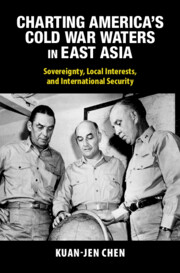 Charting America's Cold War Waters in East Asia
Charting America's Cold War Waters in East Asia Published online by Cambridge University Press: 23 May 2024
The collapse of the Japanese Empire in the aftermath of World War II left a power vacuum in maritime East Asia. The United States recognised this opportunity to shape the emerging Cold War and the geopolitical landscape of the western Pacific rim. Despite the lack of consensus among decision-makers in Washington, on-site naval commanders could effectively influence the US strategy in the region. The US Navy selected Chiang Kai-shek’s Nationalist China as a local partner to assume responsibility for guarding the western Pacific rim. This decision was based not only on Chiang’s good relationship with the US Navy, which allowed it to enter China’s territorial waters and ports, but also on the belief that a pro-US Chinese navy could help secure America’s naval dominance in the region. With US military and financial support, Chiang successfully rebuilt a modern Nationalist navy. However, the ongoing power struggle between the Nationalists and the Communists made the situation unpredictable in maritime East Asia.
To save this book to your Kindle, first ensure [email protected] is added to your Approved Personal Document E-mail List under your Personal Document Settings on the Manage Your Content and Devices page of your Amazon account. Then enter the ‘name’ part of your Kindle email address below. Find out more about saving to your Kindle.
Note you can select to save to either the @free.kindle.com or @kindle.com variations. ‘@free.kindle.com’ emails are free but can only be saved to your device when it is connected to wi-fi. ‘@kindle.com’ emails can be delivered even when you are not connected to wi-fi, but note that service fees apply.
Find out more about the Kindle Personal Document Service.
To save content items to your account, please confirm that you agree to abide by our usage policies. If this is the first time you use this feature, you will be asked to authorise Cambridge Core to connect with your account. Find out more about saving content to Dropbox.
To save content items to your account, please confirm that you agree to abide by our usage policies. If this is the first time you use this feature, you will be asked to authorise Cambridge Core to connect with your account. Find out more about saving content to Google Drive.